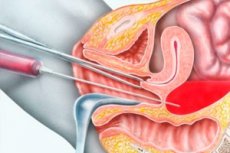Medical expert of the article
New publications
Abdominal puncture through the posterior vaginal arch
Last reviewed: 07.07.2025

All iLive content is medically reviewed or fact checked to ensure as much factual accuracy as possible.
We have strict sourcing guidelines and only link to reputable media sites, academic research institutions and, whenever possible, medically peer reviewed studies. Note that the numbers in parentheses ([1], [2], etc.) are clickable links to these studies.
If you feel that any of our content is inaccurate, out-of-date, or otherwise questionable, please select it and press Ctrl + Enter.

Puncture of the posterior fornix is performed in a hospital setting, observing the rules of asepsis and antisepsis, using a thick needle 10-12 cm long, attached to a 10 ml syringe.
Indications for the procedure
An indication for a puncture through the posterior vaginal fornix is a suspected presence of free fluid in the pelvic cavity to clarify the diagnosis of ectopic pregnancy, with an unclear clinical picture. In case of difficult differential diagnosis between pelvic peritonitis and a disrupted ectopic pregnancy, a puncture helps to identify the inflammatory process. A puncture through the anterior abdominal wall is performed in the presence of ascites. Ascitic fluid is examined for the content of atypical cells to exclude a malignant tumor. The absence of atypical cells in the ascitic fluid may indicate a connection between ascites and heart disease, liver cirrhosis. A puncture through the posterior fornix is performed if a tubal pregnancy is suspected, sometimes in acute inflammatory processes of the uterine appendages and pelvic peritoneum in order to detect blood, serous or purulent effusion in the abdominal cavity.
Puncture is used to take an aspirate when ovarian cancer is suspected.
Preparation
Before the operation, it is necessary to empty the bladder and intestines. When puncturing the posterior fornix, inhalation, intravenous anesthesia or local anesthesia with 0.25% novocaine solution in the amount of 5.0-10.0 ml is used through the posterior fornix of the vagina.
Posterior fornix puncture technique
The patient is placed on a gynecological chair. The external genitalia, vagina and cervix are disinfected with alcohol and 5% iodine tincture. Using a posterior speculum and a lifter, the vaginal portion of the cervix is exposed and the posterior lip is grasped with bullet forceps. The lifter is removed and the posterior speculum is handed to an assistant. The cervix is pulled towards you and forward with bullet forceps, while the posterior wall of the vagina is pressed with a speculum, thereby maximally stretching the posterior fornix. Under the cervix, strictly along the midline, 1 cm away from the transition of the fornix to the vaginal portion of the cervix, a needle is inserted through the posterior fornix. The needle penetrates to a depth of 2-3 cm. When the fornix is punctured, there is a sensation of the needle falling into the void. After this, you need to pull the plunger of the syringe towards you. The liquid is drawn into the syringe. If the liquid does not go into the syringe, you can carefully push the needle deeper or, conversely, slowly pull it out and simultaneously pull the syringe piston towards you. The resulting puncture is examined, its nature, color, and smell are determined.
According to the indications, it is subjected to bacteriological, cytological or biochemical examination. In case of interrupted ectopic pregnancy, the puncture will be liquid blood of a dark color. Small dark clots of blood are found on a white napkin.

